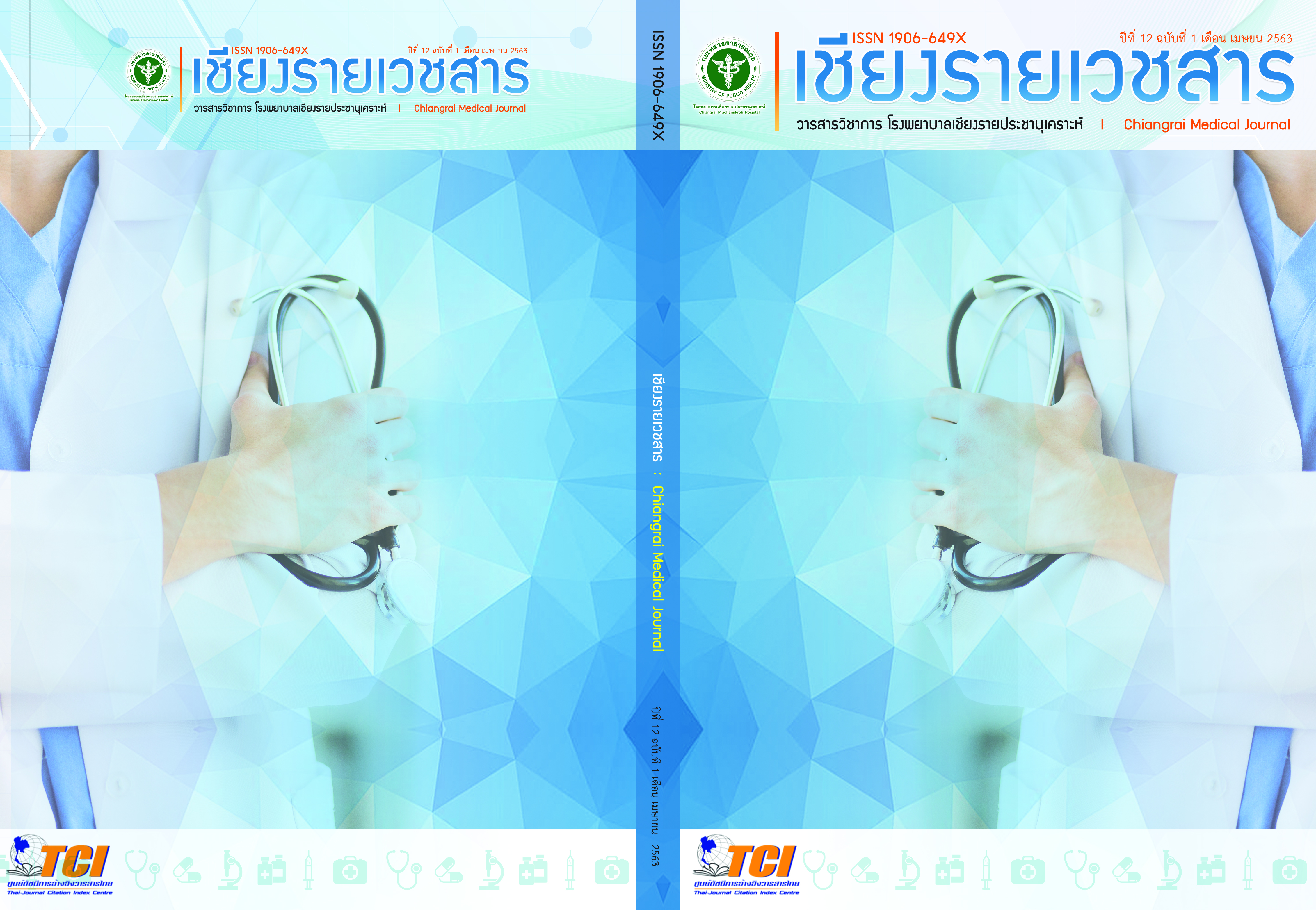สื่ออินเตอร์เน็ตช่วยเพิ่มประสิทธิผลในการรักษาโรคปวดกล้ามเนื้อผังพืดคอหรือไม่
Main Article Content
บทคัดย่อ
ความเป็นมา
ปัจจุบันการใช้สื่ออินเตอร์เน็ตเข้ามามีบทบาทมากขึ้นทางการแพทย์ ทั้งในเรื่องความรู้เกี่ยวกับโรค สาเหตุ ปัจจัย และวิธีการรักษา ซึ่งเป็นสื่อกลางที่ประชาชนเข้าถึงได้ง่าย สะดวกรวดเร็ว โดยพบว่าบางโรคการใช้สื่ออินเตอร์เน็ตนั้นสามารถเพิ่มความสามารถในการจัดการตัวเองและลดปวดได้
วัตถุประสงค์
ศึกษาประสิทธิผลของการใช้สื่ออินเตอร์เน็ตเสริมการรักษามาตรฐานเพื่อลดอาการปวดคอในผู้ป่วยปวดกล้ามเนื้อพังผืดคอ
วิธีการศึกษา
เป็นการวิจัยเชิงทดลองแบบสุ่มและมีกลุ่มควบคุม ได้ทำการสุ่มแบบแบ่งขั้นผู้ป่วยปวดกล้ามเนื้อพังผืดคอจำนวน 48 คนเป็น 2 กลุ่ม ทั้งสองกลุ่มจะได้รับการรักษาตามวิธีมาตรฐานได้แก่การรักษาด้วยยา สอนการออกกำลังกาย การทำกายภาพบำบัด การให้ความรู้ตามหลักการยศาสตร์ หรือการฝังเข็มโดยแพทย์เวชศาสตร์ฟื้นฟู เฉพาะกลุ่มทดลองจะได้รับเชิญให้เข้าร่วมเป็นสมาชิกเว็บไซต์เกี่ยวกับโรคปวดคอ(www.bhudneckpain.com) ประเมินอาการปวด, ภาวะทุพพลภาพ โดยใช้ Face numerical pain rating scale (FNPRS), และ Neck disability index (NDI) ตามลำดับ โดยประเมินทุกมิติตั้งแต่เริ่มเข้าร่วมวิจัย ที่หนึ่งเดือน และสามเดือน
ผลการศึกษา
อาสาสมัคร 48 ราย ทั้งหมดอยู่จนสิ้นสุดงานวิจัย อายุเฉลี่ยของอาสาสมัคร 31.04 ± 8.13 ปี ผลการศึกษาพบว่า FNPRS ของกลุ่มทดลองมีการลดลงมากกว่ากลุ่มควบคุมอย่างมีนัยสำคัญทางสถิติที่สามเดือน (2.4 ±1.2 VS 4.7 ± 1.8; P< 0.001) คะแนน NDI ของกลุ่มทดลองมีคะแนนลดลงมากกว่ากลุ่มควบคุมอย่างมีนัยสำคัญทางสถิติที่ระยะเวลาสามเดือน(7.5 ±5.3 VS 11.3 ±5.0 ;P= 0.012)
สรุปและข้อเสนอแนะ
การใช้สื่ออินเตอร์เน็ตร่วมกับการรักษามาตรฐานมีประสิทธิผลในการรักษาผู้ป่วยปวดกล้ามเนื้อพังผืดคอได้ดีกว่าการรักษาแบบมาตรฐานเพียงอย่างเดียว แต่เนื่องจากงานวิจัยอายุเฉลี่ยอยู่ในวัยทำงานจึงไม่สามารถใช้ข้อมูลงานวิจัยนี้กับอายุช่วงอื่นๆได้ รวมถึงผลของการใช้สื่ออินเตอร์เน็ตที่ระยะมากกว่าสามเดือนนั้นไม่สามารถระบุได้ดังนั้นในงานวิจัยถัดไปควรศึกษาในอาสาสมัครกลุ่มใหญ่และติดตามในระยะเวลานานขึ้น
Article Details
เอกสารอ้างอิง
2. Childs JD, Fritz JM, Piva SR, Whitman JM. Proposal of a classification system for patients with neck pain. J Orthop Sports Phys Ther 2004;34:686-96.
3. Childs JD, Cleland JA, Elliott JM, Teyhen DS, Wainner RS, Whitman JM, et al. Neck pain: Clinical practice guidelines linked to the International Classification of Functioning, Disability, and Health from the Orthopedic Section of the American Physical Therapy Association. J Orthop Sports Phys Ther 2008;38:1-34.
4. Ferrante FM, Bearn L, Rothrock R, King L. Evidence against trigger point injection technique for treatment of cervicothoracic myofascial pain with botulinum toxin type A. Anesthesiology 2005;103:377-83.
5. Travell JG, Simons DG. Myofascial pain and dysfunction: the trigger point manual. 2nd ed. Baltimore: Williams and wilkins; 1999.
6. อานนท์ พงศ์ธรกุลพานิช, พรฑิตา ชัยอำนวย, ไพจิตต์ อัศวธนบดี, อุรุยา ก้องเกียรติงาม. Myofasacial pain syndrome in Thai community. จุลสารรูมาติสซั่ม 2538;4:2.
7. Mehul J, Vikramjeet S, Shawnjeet S. Myofascial Pain Syndrome: a Treatment Review. Pain Ther 2013;2:21–36.
8. Teasell RW, McClure JA, Walton D, Pretty J, Salter K, Meyer M, et al. A research synthesis of therapeutic interventions for whiplash-associated disorder: part 1- overview and summary. Pain Res Manage 2010;15:287–94.
9. Teasell RW, McClure JA, Walton D, Pretty J, Salter K, Meyer M, et al. A research synthesis of therapeutic interventions for whiplash-associated disorder (WAD): part 4 - noninvasive interventions for chronic WAD. Pain Res Manage 2010;15:3.
10. Rebeck T. The role of exercise and patient education in the noninvasive management of whiplash. J Orthop Sports Phys Ther 2017;47:481–91.
11. Michael j, Curtis W. Common neck problems. In Braddom RL, editor. Physical Medicine and Rehabilitation 4th ed. Philadelphia: Elsevier; 2007;787-815.
12. Neve M, Morgan PJ, Jones PR, Collins CE. Effectiveness of web-based interventions in achieving weight loss and weight loss maintenance in overweight and obese adults: a systematic review with meta-analysis. Obes rev 2010;11(4):306-21.
13. กระทรวงเทคโนโลยีสารสนเทศและการสื่อสาร สำนักงานสถิติแห่งชาติ. สำรวจการมีการใช้เทคโนโลยีสารสนเทศและการสื่อสารในครัวเรือน พ.ศ. 2556
14. Krein SL, Kadri R, Hughes M, Kerr EA, Piette JD, Holleman R, et al. Pedometer-based internet-mediated intervention for adults with chronic low back pain: randomized controlled trial. J Med Internet Res 2013;15(8):181.
15. Van MH, Schoones JW, Vliet TP. Internet-based physical activity interventions: a systematic review of the literature. J Med Internet Res 2007;9(3):26.
16. Solomon M, Wagner SL, Goes J. Effects of a Web-based intervention for adults with chronic conditions on patient activation: online randomized controlled trial. J Med Internet Res 2012;14(1):32.
17. Anneli P, Maria L, Gunnel P. Neck-specific exercises with internet-based support compared to neck-specific exercises at a physiotherapy clinic for chronic whiplash-associated disorders: study protocol of a randomized controlled multicentre trial. BMC Musculoskelet Disord 2017;18:524.
18. Kipping S, Stuckey M, Hernandez A, Nguyen T, Riahi S. A web based patient portal for mental health care. J Med Internet Res 2016;18:294.
19. Overmeer T, Peterson G, Landén M, Peolsson A. The effect of neck-specific exercise with or without a behavioral approach on psychological factors in chronic whiplash-associated disorders: A randomized controlled trail with a 2 year follow up. Medicine 2016;95:4430.
20. Ardern C, Peterson G, Ludvigsson M, Peolsson A. Satisfaction with the outcome of physical therapist-prescribed exercise in chronic whiplash associated disorders. J Orthop Sports Phys Ther 2016;46:640–9.
21. Treleaven J, Peterson G, Ludvigsson ML, Kammerlind AS, Peolsson A. Balance, dizziness and proprioception in patients with chronic whiplash associated disorders complaining of dizziness: a prospective randomized study comparing three exercise programs. Manual therapy 2016;22:122–30.
22. Cuijpers P, van Straten A, Andersson G. Internet-administered cognitive behavior therapy for health problems: a systematic review. J Behav Med 2008;31:169–77.
23. Sjöström M, Umefjord G, Stenlund H, Carlbring P, Andersson G, Samuelsson E. Internet-based treatment of stress urinary incontinence: a randomized controlled study with focus on pelvic floor muscle training. BJU Int 2013; 112:362–72.
24. Revenäs Å, Opava C, Ahlén H, Brusewitz M, Pettersson S, Åsenlöf P. Mobile internet service for self-management of physical activity in people with rheumatoid arthritis: evaluation of test version. RMD open 2016;2:214.
25. Andersson G. Using internet to provide cognitive behavior therapy. Behav Res Ther 2009;47:175–80.
26. Garg S, Garg D, Turin TC, Chowdhury MF. Web-based interventions for chronic back pain: A systematic review. J Medical Internet Res 2016;18:139.
27. Shukla H, Nair SR, Thakker D. Role of telerehabilitation in patients following total knee arthroplasty: evidence from a systematic literature review and meta-analysis. J Telemed Telecare 2017;23:339–46.
28. Bring A, Åsenlöf P, Söderlund A. What is the comparative effectiveness of current standard treatment, against an individually tailored behavioural programme delivered either face-to face for people with acute whiplash associated disorder?: A randomized controlled trial. Clin Rehabil 2016;30:441–53.
29. Panya L, Thanet W, Somyot W, Sanya S, Cholavech C. Reliability and validity study of a Thai version of the neck disability index in patients with neck pain. J Med Assoc Thai 2012;95(5):681-8.
30. Anneli P, Maria L, Gunnel P. Neck-specific exercises with internet-based support compared to neck-specific exercises at a physiotherapy clinic for chronic whiplash-associated disorders: study protocol of a randomized controlled multicentre trial. BMC Musculoskelet Disord 2017;18:524.


